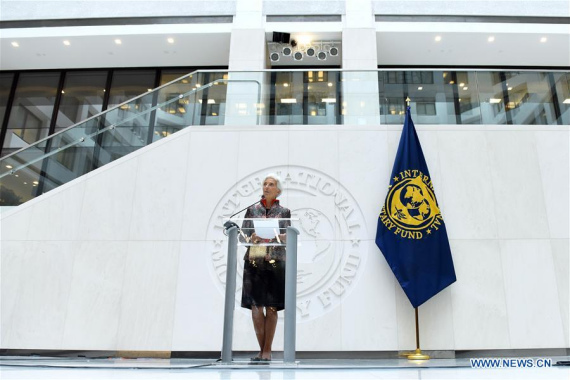
International Monetary Fund (IMF) Managing Director Christine Lagarde speaks on launch of the new Special Drawing Right (SDR) basket including the Chinese currency, the renminbi (RMB) in Washington D.C., the United States, Sept. 30, 2016. (Photo: Xinhua/Yin Bogu)
The Chinese yuan's recent inclusion in the International Monetary Fund (IMF)'s Special Drawing Rights (SDR) basket is expected to facilitate investments in Egypt, said Egyptian experts.
"The yuan SDR inclusion will facilitate Egyptian-Chinese trade and encourage more Chinese investments in Egypt, because the Chinese investors will use the yuan in Egypt and the Arab country will use it as a recognized currency for its imports from China," said Gamal Bayoumi, head of the Arab Investors Union and also chief of Egypt-Europe Cabinet Unit.
The economist added that the Chinese investors in Egypt are expected to expand their businesses after this step, noting the use of China's yuan in Egypt will be positively reflected on the relations between the two countries.
China has been working hard on its yuan globalization and the move is considered a step for the Chinese local currency toward becoming a global reserve currency.
"It is a great step for China and the developing countries it represents, as it is the first time for a third world country to have its local currency globally recognized," Bayoumi told Xinhua.
Chinese President Xi Jinping proposed in 2013 the Belt and Road Initiative that refers to the Silk Road Economic Belt linking China with Europe through Central and Western Asia by inland routes and the 21st Century Maritime Silk Road connecting China with Southeast Asia, Africa and Europe by sea.
The initiative offers both a long-term development vision and real benefits in the near future for participant states.
"Egypt responsibly responded to the initiative and is preparing to contribute through its key portal of the Suez Canal," said Nasser Abdel-Aal, expert in Asian affairs and professor of Chinese studies at Cairo-based Ain Shams University.
The professor explained that Egypt expanded the vital waterway and is working on the establishment of six new tunnels in the canal region as part of the Suez Canal corridor development project, which is carried out with the contribution of Chinese investments as well.
"The development of the Suez Canal region will serve the initiative and lead to greater economic and commercial cooperation between the two countries," Abdel-Aal told Xinhua.
"China's investments in Egypt need hard currency. So, when the yuan is globally recognized, it will benefit both China and Egypt as it will facilitate their mutual trade and investment," the professor continued.
He argued that the use of the yuan will benefit the Chinese businesses in Egypt as they will not have to use the dollar as an intermediate currency in the Arab country.
Egypt is currently facing economic recession due to political turmoil over the past five years, which led to the decline of its foreign currency reserves from 36 billion U.S. dollars in early 2011 to 19.59 billion dollars by the end of September.
For Ehab al-Desouki, head of the Economy Department of Cairo-based Sadat Academy, the step will benefit Egypt when it gets loans from China, as it can get them and pay them back in yuan instead of dollars.
"Egypt cannot borrow from another country in yuan, and the dollar is still the main currency for Egyptian imports and exports," Desouki said. "I believe it will take time until Egypt greatly benefits from the yuan SDR inclusion."
The two countries decided in late 2014 to elevate the level of their cooperation to "a comprehensive strategic partnership."
The bilateral annual trade exchange has exceeded 12 billion U.S. dollars, mostly represented in Chinese exports.


















































